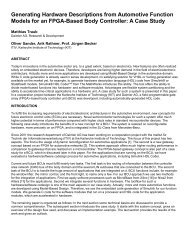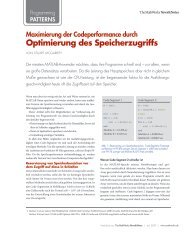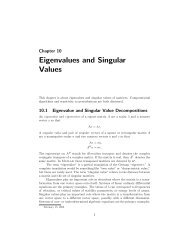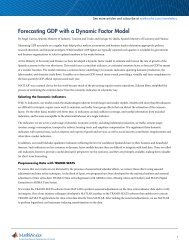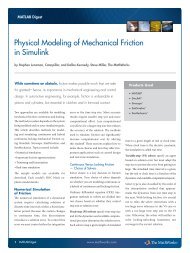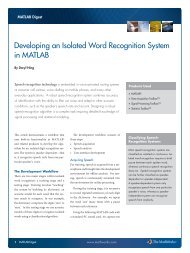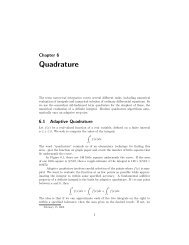Chapter 8 Exponential Function - MathWorks
Chapter 8 Exponential Function - MathWorks
Chapter 8 Exponential Function - MathWorks
Create successful ePaper yourself
Turn your PDF publications into a flip-book with our unique Google optimized e-Paper software.
The result gives us the numerical value of e correct to 16 significant decimal digits.<br />
It’s easy to remember the repeating pattern of the first 10 significant digits.<br />
e = 2.718281828...<br />
Let’s derive a more useful representation of the exponential function. Start<br />
by putting t back in the picture.<br />
e t = ( lim<br />
h→0 (1 + h) 1/h ) t<br />
= lim<br />
h→0 (1 + h) t/h<br />
Here is the Binomial Theorem.<br />
(a + b) n = a n + na n−1 b +<br />
n(n − 1)<br />
a<br />
2!<br />
n−2 b 2 +<br />
n(n − 1)(n − 2)<br />
a<br />
3!<br />
n−3 b 3 + ...<br />
If n is an integer, this terminates after n+1 terms with b n . But if n is not an integer,<br />
the expansion is an infinite series. Apply the binonimial theorem with a = 1, b = h<br />
and n = t/h.<br />
(1 + h) t/h (t/h)(t/h − 1)<br />
= 1 + (t/h)h + h<br />
2!<br />
2 (t/h)(t/h − 1)(t/h − 2)<br />
+ h<br />
3!<br />
3 + ...<br />
t(t − h)<br />
= 1 + t + +<br />
2!<br />
t(t − h)(t − 2h)<br />
+ ...<br />
3!<br />
Now let h go to zero. We get the power series for the exponential function.<br />
e t = 1 + t + t2 t3 tn<br />
+ + ... + + ...<br />
2! 3! n!<br />
This series is a rigorous mathematical definition that applies to any t, positive or<br />
negative, rational or irrational, real or complex. The n + 1-st term is t n /n!. As<br />
n increases, the t n in the numerator is eventually overwhelmed by the n! in the<br />
denominator, so the terms go to zero fast enough that the infinite series converges.<br />
It is almost possible to use this power series for actual computation of e t . Here<br />
is an experimental Matlab program.<br />
function s = expex(t)<br />
% EXPEX Experimental version of EXP(T)<br />
s = 1;<br />
term = 1;<br />
n = 0;<br />
r = 0;<br />
while r ~= s<br />
r = s;<br />
n = n + 1;<br />
term = (t/n)*term;<br />
s = s + term;<br />
end<br />
5







